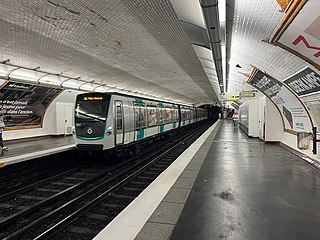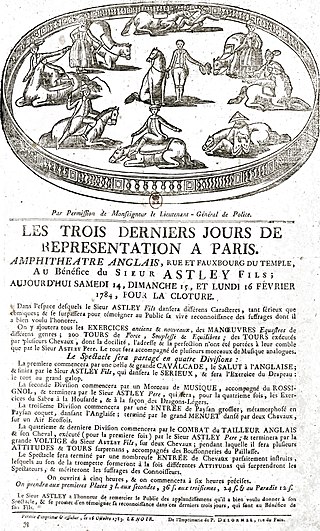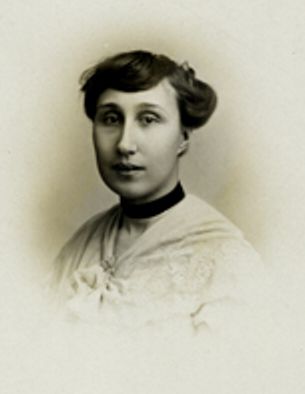
Montmartre is a large hill in Paris's northern 18th arrondissement. It is 130 m (430 ft) high and gives its name to the surrounding district, part of the Right Bank. Montmartre is primarily known for its artistic history, for the white-domed Basilica of the Sacré-Cœur on its summit, and as a nightclub district.

The 11th arrondissement of Paris is one of the 20 arrondissements of the capital city of France. In spoken French, the arrondissement is referred to as le onzième.

Anvers is a station on Line 2 of the Paris Métro. It is located in Montmartre, on the border of the 9th and the 18th arrondissements.

Oberkampf is a station of the Paris Métro, serving Lines 5 and 9 and located in the 11th arrondissement of Paris.

Le Chat Noir was a 19th century entertainment establishment in the bohemian Montmartre district of Paris. It was opened on 18 November 1881 at 84 Boulevard de Rochechouart by impresario Rodolphe Salis, and closed in 1897 not long after Salis' death.

Annie Violette Fratellini was a French circus artist, singer, film actress and clown.

The Cirque Olympique in Paris, also known as the Cirque Franconi, was an equestrian theatre company, founded in 1782 by Philip Astley, the English inventor of the modern circus ring, and was initially known as the Cirque d'Astley or the Cirque Anglais.

The Cirque d'Hiver, located at 110 rue Amelot, has been a prominent venue for circuses, exhibitions of dressage, musical concerts, and other events, including exhibitions of Turkish wrestling and even fashion shows. The theatre was designed by the architect Jacques Ignace Hittorff and was opened by Emperor Napoleon III on 11 December 1852 as the Cirque Napoléon. The orchestral concerts of Jules Etienne Pasdeloup were inaugurated at the Cirque Napoléon on 27 October 1861 and continued for more than twenty years. The theatre was renamed Cirque d'Hiver in 1870.

The Passage des Panoramas is the oldest of the covered passages of Paris, located in the 2nd arrondissement between the Boulevard Montmartre to the north and the Rue Saint-Marc to the south. It is one of the earliest venues of the Parisian philatelic trade, and it was one of the first covered commercial passageways in Europe. Bazaars and souks in the Orient had roofed commercial passageways centuries earlier, but the Passage de Panoramas innovated in having glazed roofing and, later on, in 1817, gas lights for illumination. It was an ancestor of the city gallerias of the 19th century and the covered suburban and city shopping malls of the 20th century.

The Boulevard Marguerite-de-Rochechouart is a street in Paris, France, situated at the foot of Montmartre and to its south. Like the neighbouring street, it is named after Marguerite de Rochechouart de Montpipeau (1665–1727), abbess of Montmartre. It is a result of the 1864 merging of the boulevards and chemins de ronde which followed the interior and exterior of the Wall of the Farmers-General. It has also been known as the Boulevard des Poissonniers, Chemin de ronde de Poissonnière and Chemin de ronde de Rochechouart. It is served by the Paris Metro stations Pigalle, Anvers and Barbès – Rochechouart.

Louis Rodolphe Salis was the creator, host and owner of the Le Chat Noir cabaret. With this establishment Salis is remembered as the creator of the modern cabaret: a nightclub where the patrons could sit at tables with alcoholic drinks and enjoy variety acts on a stage, introduced by a master of ceremonies who interacted with the audience.

The Rue des Martyrs is a street that passes through the 9th and 18th arrondissements of Paris, France.

Family of Saltimbanques is a 1905 oil on canvas painting by Pablo Picasso. The work depicts six saltimbanques, a kind of itinerant circus performer, in a desolate landscape. It is considered the masterpiece of Picasso's Rose Period, sometimes called his circus period. The painting is housed in the collection of the National Gallery of Art in Washington, D.C.

The Vesque Sisters were two French artist sisters, Marthe and Juliette, who, between 1900 and 1949, frequented Parisian circuses and documented circus life and performances in well-executed paintings. The sisters attended weekly shows where the performers were sketched live at both circus and variety theaters. Their records constitute a unique documentation of European circus in the first half of the twentieth century. Their extensive journal entries from 1904 to 1947 added fascinating information and insights, written in a vigorous style and teeming with gossip about the circus community, with a marvellous eye for detail.

The Boulevard Barbès is a boulevard in the 18th arrondissement of Paris. It is named after French politician Armand Barbès. It was built in 1867 during Haussmann's renovation of Paris. It starts at the boulevard de la Chapelle and ends at the rue Ordener. It is 835 metres long and 35 metres wide.

The Circus is an oil on canvas painting by Georges Seurat. It was his last painting, made in a Neo-Impressionist style in 1890–91, and remained unfinished at his death in March 1891. The painting is located at the Musée d'Orsay in Paris.

Rosa Bouglione was a French circus performer and the matriarch of the Bouglione circus family.

Famille d'acrobates avec singe is a 1905 painting by Pablo Picasso. It depicts a family of travelling circus performers during an intimate moment. The work was produced on cardboard using mixed media: gouache, watercolour, pastel and Indian ink. It is held by the Gothenburg Museum of Art in Gothenburg, Sweden. The work was painted at a key phase in Picasso's life, as he made the transition from an impoverished bohemian at the start of 1905 to a successful artist by the end of 1906.
Kaely Michels-Gualtieri is an American trapeze artist known for her work as a leading artist with the Ringling Bros. and Barnum & Bailey Circus, often performing under the stage name "Electra". She is the winner of two Golden Flyer Awards as one of the world's leading swing trapeze artists. She won a Silver Ring, Russia's highest trapeze honor, in 2017. She is the youngest person ever nominated for membership in the Circus Hall of Fame.




















